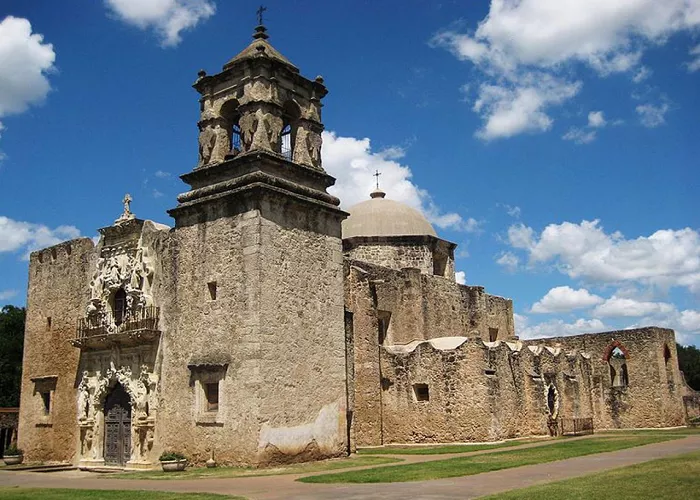Texas is rich in history, with numerous sites that tell the story of its past. Among these, The Alamo in San Antonio stands out as the most iconic and historically significant place to visit. This site offers insights into the state’s fight for independence and its diverse cultural heritage.
Geographical Location
The Alamo is located in downtown San Antonio, Texas. Situated near the San Antonio River, it is easily accessible to visitors and is part of the San Antonio Missions National Historical Park. The site’s central location makes it a focal point for understanding the geography of early Texas settlements.
Historical Background of The Alamo
The Alamo was originally established in 1718 as the Mission San Antonio de Valero by Spanish missionaries. It served the purpose of converting local Indigenous peoples, particularly the Coahuiltecan tribes, to Christianity. By the late 18th century, the mission was secularized and later transformed into a military outpost by Spanish and Mexican forces.
In 1836, the Alamo became the site of one of the most significant and tragic events in American history—the Battle of the Alamo, during the Texas Revolution. A small group of Texan revolutionaries, including iconic figures such as Davy Crockett, James Bowie, and William B. Travis, defended the fort for 13 days against thousands of Mexican soldiers led by General Antonio López de Santa Anna.
Although the defenders were ultimately defeated, their courage became a symbol of Texan independence. “Remember the Alamo!” became a powerful rallying cry for the Texian Army, leading to eventual victory at the Battle of San Jacinto.
Architectural and Archaeological Significance
The Alamo’s structure is a blend of Spanish colonial architecture with regional adaptations. Made from limestone and built with simple but enduring designs, the chapel remains the most recognizable structure today. Its façade, with a distinctive curved gable, has become a symbol of Texas itself.
Archaeological digs around the Alamo have uncovered layers of history, including Indigenous artifacts, Spanish colonial relics, and 19th-century military tools. These findings help researchers understand the diverse peoples who lived, worked, and fought here.
Role in Texan and American Identity
The Alamo is more than a historic building—it is a symbol of sacrifice, resistance, and cultural convergence. It embodies the blending of Indigenous, Spanish, Mexican, and Anglo-American influences that shaped Texas.
Educational programs at the Alamo emphasize inclusive storytelling, highlighting voices from all sides of the conflict. This approach helps visitors understand the complexity of Texan identity, moving beyond myths to embrace a more accurate and nuanced narrative.
Modern-Day Preservation and Recognition
The Alamo is a UNESCO World Heritage Site and part of the San Antonio Missions National Historical Park. It is managed by the Texas General Land Office, with restoration and preservation efforts ongoing to protect its historical integrity.
Recent projects have focused on restoring surrounding areas and interpreting lesser-known aspects of the site’s past, including its role in Indigenous and Mexican history. Preservationists are also working to balance urban development with the site’s historical importance.
Ecological and Urban Setting
Located in downtown San Antonio, The Alamo sits near the San Antonio River, a key ecological corridor for the region. The mission’s original location was chosen for its proximity to water, fertile land, and trade routes.
Today, the nearby River Walk is a blend of historical awareness and ecological design, promoting green space and tourism simultaneously. Environmental education around The Alamo also addresses topics like urban sustainability, native plants, and water conservation, making it relevant to modern environmental challenges.
Local Economy and Tourism
The Alamo significantly boosts the San Antonio economy, drawing over 2 million visitors each year. Hotels, local shops, museums, and restaurants benefit from this influx. Events like reenactments, guided tours, and heritage days support local businesses and create jobs.
Additionally, the site attracts international visitors, making it a key player in global cultural tourism. The income generated is often reinvested into further historic preservation and community programs.
Accessibility and Visitor Experience
The Alamo Visitor Center offers exhibits, films, and guided experiences. There are bilingual resources, making it accessible to Spanish-speaking visitors. Maps and apps help tourists navigate the historic area, and entry to the church itself is free, though advanced reservations are encouraged for guided tours.
The nearby Alamo Plaza provides a pedestrian-friendly area filled with information panels, statues, and memorials. Visitors can also explore connected sites like the Long Barrack, Cavalry Courtyard, and the Alamo Gardens.
Fun Facts About The Alamo
- The word “Alamo” comes from the Spanish word for “cottonwood”, named after the trees nearby.
- The original mission was relocated three times before settling in San Antonio.
- Davy Crockett was around 49 years old during the Battle of the Alamo, not the young frontiersman often depicted.
- In the 20th century, it was even used as a grocery warehouse before preservation efforts began.
Conclusion
The Alamo is the most historical place to visit in Texas not only because of its battlefield past but also due to its deep cultural layers, economic influence, and ecological setting. It tells a story of courage, identity, and resilience that continues to inspire visitors from around the world.
Whether you’re interested in history, architecture, nature, or Texan pride, The Alamo offers an experience that’s as educational as it is emotional. Visiting this site is a powerful reminder of the sacrifices made in the name of freedom and the diverse cultures that shaped modern Texas.

